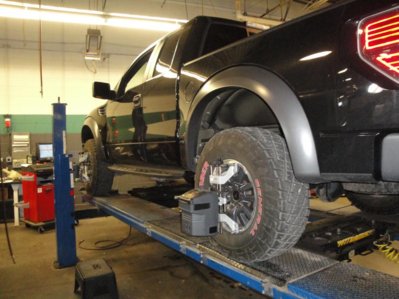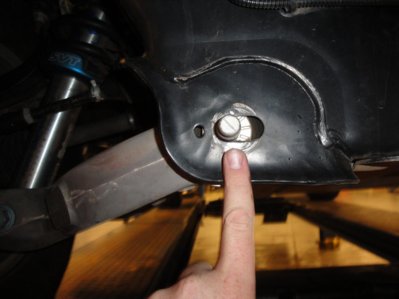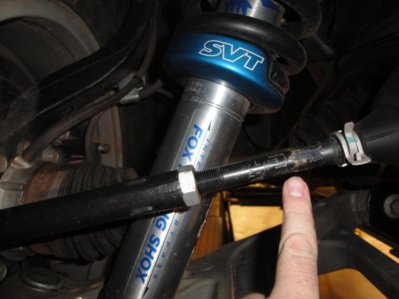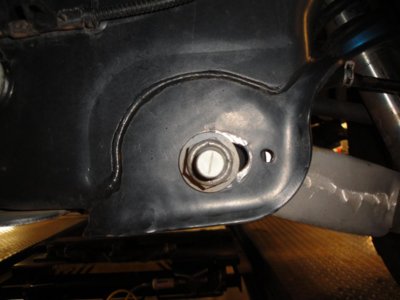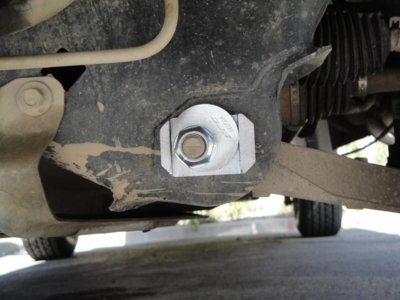Right after I got my truck, I performed the shock leveling mod, setting it to the number 2 position. I did this after work one night and by the time I got to the alignment, I was pretty spent for the day. So I just did a quick alignment and called it good. Since I had only adjusted my Toe that night, I knew my Camber and Caster angles where still out of spec. Eventually my front tires would show the effects. I'm going on a little road trip tomorrow (to find me a slutty chick named Camber....just keep reading), so I figured I better revisit my alignment today before me and my tires regretted not doing it sooner.
So I thought I would take some picture, write up a little (or maybe big) story, and share it with FRF; because who DOESN'T enjoy learning about their Raptor (or future Raptor )? Now, I wouldn't call this a "how to" write up because no matter how much you know about steering, suspensions, and alignments, without the proper equipment, doing an accurate alignment is impossible. So this is more of a basic "how things work" write up. I'm going to keep everything in this write up Raptor related, so no, the points of adjustment that are shown here will NOT be the same on your Prius lol.
)? Now, I wouldn't call this a "how to" write up because no matter how much you know about steering, suspensions, and alignments, without the proper equipment, doing an accurate alignment is impossible. So this is more of a basic "how things work" write up. I'm going to keep everything in this write up Raptor related, so no, the points of adjustment that are shown here will NOT be the same on your Prius lol.
I think everyone understands what an alignment is, and why it needs to be checked and corrected every once in awhile. Typically I see vehicle owners getting the alignment checked every 30k, or after a new set of tires are installed. As long as you keep an eye out for abnormal tire wear, this is a fine way to go about it. But, depending on how hard/much you drive your Raptor off road, you may need to have it check more often then that. For instance, I've put about 2,500 miles (a couple hundred of them being off road) on my truck since I performed that last alignment. Comparing my measurement from that night, to todays measurement, shows that at some point while gettin "Baja" with the Raptor, I knocked the right front wheel/suspension even farther out of whack.
I had lost some positive Caster, and gained some negative Camber in the right front. In a tight steering and handling sports car, this unintended "adjustment" would've probably been immediately noticed. But with 35 inch tires, a foot of ground clearance, a sway bar gone MIA, and a soft suspension, I never felt the change. So for some of you, it maybe a good idea to get your alignment checked more often then not.
Basic alignment angles,
Toe, is the measurement of the leading or trailing edges of your tires. Positive Toe, or to "in", would mean that when looking at the tires horizontally from the front of your truck, they would look turned in towards each other. Negative Toe, or Toe "out" means the opposite. The tires would look like they're steering out and away from each other.
Total Toe is the difference or combined amount of Toe in each wheel. So if each tire had 6 degrees of positive Toe, your Total Toe would be 12 degrees positive. If one tire had 6 degrees positive and the other tire had 3 degrees negative, you would have a total Toe of 3 degrees positive. Zero Toe means, zero combined or difference of Toe.
Incorrect/out of spec Toe amounts can cause feathering/cupping over the tread blocks of the tire; it can cause a pull or a wander feeling when going down the road. Negative Toe has a greater affect on tire wear, pulls, and wandering then positive Toe.
Adding a slight amount (2-3 degrees) of Total positive Toe during an alignment will help the vehicle track straight down the road without affecting tire wear. It also gives you more cushion in the event that the alignment gets knocked out of whack. If the total Toe was set to zero, and it got knocked, it may go positive (not always a bad thing) or it may go negative, possibly causing tire wear, pull/wandering. By setting the total Toe slightly positive, it takes a harder whack to move the total toe negative (bad). Clear-as-mud!! lol
Camber, is the measurement of the vertical inward/outward tilt of the tire. Negative Camber means, when looking at the side of the truck, the top of the tire will look tilted inward. Positive Camber means the opposite, the tire would look tilted outward.
Or,
Positive/negative Camber can be remembered like this (if your a man that is); visualize a chick named Camber, shes hot, naked, and laying on her back in your bed; her legs are the front tires, her knees being the top of the tires; if her legs were closed, knees tilted in, that would be negative (BAD) Camber, if here legs were open, knees tilted out, that would be positive (GOOD) Camber.
Incorrect/out of spec Camber will cause tire wear and pull. Positive Camber puts the vehicle weight on the outside edge of the tire causing outside tire wear . Negative Camber puts the vehicle weight on the inside of the tire causing inside tire wear. Affects of Camber wear on a tire tread is smooth and uniform. The vehicle will pull to the side with the most amount of positive Camber. Ideally the Camber should be set as close to zero (on each side) as possible to prevent any tire wear or pulls. A couple degrees either way will usually not hurt anything.
Caster is the hardest to explain imo. Basically (in the Raptor's case) it's the difference between the upper and lower ball joint relative to the vertical center line of the hub. If you took your tire off and looked at your truck from the side, you should see that your upper control arm ball joint, is set farther back, or closer to the cab then compared to the lower control arm's ball joint. This would be positive Caster. If the upper control arm ball joint was ahead of the lower control arm ball joint, it would be negative caster. If the upper control arm ball joint and lower control arm ball joint are vertically aligned, neither one was behind nor ahead of the other, this would be zero Caster.
For the most part, Caster is a non tire wearing angle. In some extreme, nit picking circumstances, it will wear a tire/s; but thats going past the basics. I don't think it going to be beneficial to talk about (unless someone wants me to).
continued
The Raptor's spec's call for an equal amount of positive Caster on both sides. I can't remember a vehicle that I've aligned that didn't call for at least some positive Caster. Positive Caster gives the vehicle straight ahead stability and also helps the steering wheel return to center after a turn. Adding positive (or negative) Caster changes the axis angle that the tire is following when the steering wheel is turned. With positive Caster, when the back of your tire is being turned in, it is being forced down, meanwhile the other tire is allowed to come up. That's why, if you've ever noticed that turning your steering wheel at a stand still makes the front of your truck rise up on one side and dip down on the other, you are seeing the Caster angle at work.
Cross Caster, is the amount of difference (of Caster) between the front tires. The vehicle will pull to the side with the least amount of positive Caster. With that said, alignment techs will generally set the right side Caster angle slightly higher (more positive), to help counter a pull that road crown can create. Basically creating a pull (to the left), to counter the effects of gravity.
Last measurement/angle that I think is useful to talk about is Thrust Angle. Now, the Raptor's rear suspension angles are non adjustable. By this I mean sure, you could loosen the U bolts, and possibly get some minor adjustment. But it's not practical, nor a procedure Ford suggests doing during an alignment.
Most shops/dealers will perform a "4 wheel alignment" or a "4 wheel thrust angle alignment". You might be asking, why do I need (or why am I paying for), a "4 wheel" alignment when only the front wheels are being aligned? The answer is, so that your steering wheel will point straight.
Lets go back to the term Thrust Angle. Thrust Angle is the measurement of how squarely the rear tires are located under the chassis; or the position the tires are in, in relation to the vehicle's center line.
Negative Thrust Angle means that the front of the rear tires are pointed to the left. Positive Thrust Angle means that the front of the rear tires are pointed to the right. It is normal for the Raptor to have some amount of Thrust Angle. Ford's spec's, allow for 50 degrees +/-. My Raptor has 13 degrees of positive Thrust Angle (my rear tires point 13 degrees to the right). If I aligned the front end, and didn't account for the 13 degrees of positive Thrust Angle, my truck would seem like it pulled left (think rear-steer fork lift). To go down the road straight, I would have to correct this by turning the steering wheel to the right. Even though as far as the front end is concerned, it's all aligned correctly. Me being Mr. customer, would think my truck pulls to the left, or my steering wheel is off. This is why you need a "4 wheel" alignment, so the Thrust Angle is measured and accounted for. The front wheels will actually be slightly turned to the needed direction when the steering wheel is straight. The truck will "dog track" down the road, but its not enough to be noticed.
So I thought I would take some picture, write up a little (or maybe big) story, and share it with FRF; because who DOESN'T enjoy learning about their Raptor (or future Raptor
I think everyone understands what an alignment is, and why it needs to be checked and corrected every once in awhile. Typically I see vehicle owners getting the alignment checked every 30k, or after a new set of tires are installed. As long as you keep an eye out for abnormal tire wear, this is a fine way to go about it. But, depending on how hard/much you drive your Raptor off road, you may need to have it check more often then that. For instance, I've put about 2,500 miles (a couple hundred of them being off road) on my truck since I performed that last alignment. Comparing my measurement from that night, to todays measurement, shows that at some point while gettin "Baja" with the Raptor, I knocked the right front wheel/suspension even farther out of whack.
I had lost some positive Caster, and gained some negative Camber in the right front. In a tight steering and handling sports car, this unintended "adjustment" would've probably been immediately noticed. But with 35 inch tires, a foot of ground clearance, a sway bar gone MIA, and a soft suspension, I never felt the change. So for some of you, it maybe a good idea to get your alignment checked more often then not.
Basic alignment angles,
Toe, is the measurement of the leading or trailing edges of your tires. Positive Toe, or to "in", would mean that when looking at the tires horizontally from the front of your truck, they would look turned in towards each other. Negative Toe, or Toe "out" means the opposite. The tires would look like they're steering out and away from each other.
Total Toe is the difference or combined amount of Toe in each wheel. So if each tire had 6 degrees of positive Toe, your Total Toe would be 12 degrees positive. If one tire had 6 degrees positive and the other tire had 3 degrees negative, you would have a total Toe of 3 degrees positive. Zero Toe means, zero combined or difference of Toe.
Incorrect/out of spec Toe amounts can cause feathering/cupping over the tread blocks of the tire; it can cause a pull or a wander feeling when going down the road. Negative Toe has a greater affect on tire wear, pulls, and wandering then positive Toe.
Adding a slight amount (2-3 degrees) of Total positive Toe during an alignment will help the vehicle track straight down the road without affecting tire wear. It also gives you more cushion in the event that the alignment gets knocked out of whack. If the total Toe was set to zero, and it got knocked, it may go positive (not always a bad thing) or it may go negative, possibly causing tire wear, pull/wandering. By setting the total Toe slightly positive, it takes a harder whack to move the total toe negative (bad). Clear-as-mud!! lol
Camber, is the measurement of the vertical inward/outward tilt of the tire. Negative Camber means, when looking at the side of the truck, the top of the tire will look tilted inward. Positive Camber means the opposite, the tire would look tilted outward.
Or,
Positive/negative Camber can be remembered like this (if your a man that is); visualize a chick named Camber, shes hot, naked, and laying on her back in your bed; her legs are the front tires, her knees being the top of the tires; if her legs were closed, knees tilted in, that would be negative (BAD) Camber, if here legs were open, knees tilted out, that would be positive (GOOD) Camber.
Incorrect/out of spec Camber will cause tire wear and pull. Positive Camber puts the vehicle weight on the outside edge of the tire causing outside tire wear . Negative Camber puts the vehicle weight on the inside of the tire causing inside tire wear. Affects of Camber wear on a tire tread is smooth and uniform. The vehicle will pull to the side with the most amount of positive Camber. Ideally the Camber should be set as close to zero (on each side) as possible to prevent any tire wear or pulls. A couple degrees either way will usually not hurt anything.
Caster is the hardest to explain imo. Basically (in the Raptor's case) it's the difference between the upper and lower ball joint relative to the vertical center line of the hub. If you took your tire off and looked at your truck from the side, you should see that your upper control arm ball joint, is set farther back, or closer to the cab then compared to the lower control arm's ball joint. This would be positive Caster. If the upper control arm ball joint was ahead of the lower control arm ball joint, it would be negative caster. If the upper control arm ball joint and lower control arm ball joint are vertically aligned, neither one was behind nor ahead of the other, this would be zero Caster.
For the most part, Caster is a non tire wearing angle. In some extreme, nit picking circumstances, it will wear a tire/s; but thats going past the basics. I don't think it going to be beneficial to talk about (unless someone wants me to).
continued
The Raptor's spec's call for an equal amount of positive Caster on both sides. I can't remember a vehicle that I've aligned that didn't call for at least some positive Caster. Positive Caster gives the vehicle straight ahead stability and also helps the steering wheel return to center after a turn. Adding positive (or negative) Caster changes the axis angle that the tire is following when the steering wheel is turned. With positive Caster, when the back of your tire is being turned in, it is being forced down, meanwhile the other tire is allowed to come up. That's why, if you've ever noticed that turning your steering wheel at a stand still makes the front of your truck rise up on one side and dip down on the other, you are seeing the Caster angle at work.
Cross Caster, is the amount of difference (of Caster) between the front tires. The vehicle will pull to the side with the least amount of positive Caster. With that said, alignment techs will generally set the right side Caster angle slightly higher (more positive), to help counter a pull that road crown can create. Basically creating a pull (to the left), to counter the effects of gravity.
Last measurement/angle that I think is useful to talk about is Thrust Angle. Now, the Raptor's rear suspension angles are non adjustable. By this I mean sure, you could loosen the U bolts, and possibly get some minor adjustment. But it's not practical, nor a procedure Ford suggests doing during an alignment.
Most shops/dealers will perform a "4 wheel alignment" or a "4 wheel thrust angle alignment". You might be asking, why do I need (or why am I paying for), a "4 wheel" alignment when only the front wheels are being aligned? The answer is, so that your steering wheel will point straight.
Lets go back to the term Thrust Angle. Thrust Angle is the measurement of how squarely the rear tires are located under the chassis; or the position the tires are in, in relation to the vehicle's center line.
Negative Thrust Angle means that the front of the rear tires are pointed to the left. Positive Thrust Angle means that the front of the rear tires are pointed to the right. It is normal for the Raptor to have some amount of Thrust Angle. Ford's spec's, allow for 50 degrees +/-. My Raptor has 13 degrees of positive Thrust Angle (my rear tires point 13 degrees to the right). If I aligned the front end, and didn't account for the 13 degrees of positive Thrust Angle, my truck would seem like it pulled left (think rear-steer fork lift). To go down the road straight, I would have to correct this by turning the steering wheel to the right. Even though as far as the front end is concerned, it's all aligned correctly. Me being Mr. customer, would think my truck pulls to the left, or my steering wheel is off. This is why you need a "4 wheel" alignment, so the Thrust Angle is measured and accounted for. The front wheels will actually be slightly turned to the needed direction when the steering wheel is straight. The truck will "dog track" down the road, but its not enough to be noticed.
Last edited:


